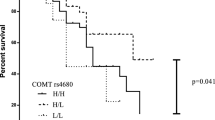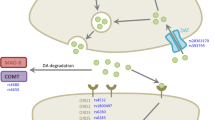Abstract
Parkinson’s disease (PD) is a multisystem disorder that affects 2–3% of the population ≥ 65 years of age. The main pharmacologic agent use in the treatment of clinical symptoms of PD is levodopa (L-DOPA). However, the chronic use of L-DOPA might result in the emergence of motor complications such as motor fluctuation and dyskinesia. Previous studies have shown that the inter-individual variability and pharmacogenetic profile of PD patients seem to influence the occurrence of motor complications. For these reasons, the purpose of this study was to evaluate a possible relationship between DRD1 A48G and DRD3 Ser9Gly genetic variants with the occurrence of motor complications in PD patients in a Brazilian population. A total of 228 patients with idiopathic PD were enrolled. Patients were genotyped for DRD1 A48G and DRD3 Ser9Gly polymorphisms using PCR–RFLP. The univariate and multivariate analyses were performed to assess the association of these polymorphisms with the occurrence of motor fluctuation and dyskinesia in PD patients. Multiple Poisson regression analyses showed a protector effect to the occurrence of dyskinesia for individuals carrying of the DRD1 G/G genotype (PR 0.294; CI 0.09–0.87; p ≤ 0.020) after the threshold Bonferroni’s. Besides, we verified risk increased to the occurrence of motor complications with daily L-DOPA dosage, disease duration, and users of rasagiline, selegiline, or entacapone (p < 0.05 for all). Our results suggest that the DRD1 A48G polymorphism and the presence of extrinsic and intrinsic factors may role an effect in the occurrence of dyskinesia in PD patients.
Similar content being viewed by others
References
Ahlskog, J. E., & Muenter, M. D. (2001). Frequency of levodopa-related dyskinesias and motor fluctuations as estimated from the cumulative literature. Movement Disorders: Official Journal of the Movement Disorder Society, 16(3), 448–458.
Balestrino, R., & Martinez-Martin, P. (2017). Neuropsychiatric symptoms, behavioural disorders, and quality of life in Parkinson’s disease. Journal of the Neurological Sciences, 373, 173–178. https://doi.org/10.1016/j.jns.2016.12.060.
Bueno-Nava, A., Gonzalez-Pina, R., Alfaro-Rodriguez, A., Avila-Luna, A., Arch-Tirado, E., & Alonso-Spilsbury, M. (2012). The selective inhibition of the D1 dopamine receptor results in an increase of metabolized dopamine in the rat striatum. Neurochemical Research, 37(8), 1783–1789. https://doi.org/10.1007/s11064-012-0790-5.
Calabresi, P., Di Filippo, M., Ghiglieri, V., & Picconi, B. (2008). Molecular mechanisms underlying levodopa-induced dyskinesia. Movement Disorders, 23(S3), S570–S579. https://doi.org/10.1002/mds.22019.
Carta, A. R., Mulas, G., Bortolanza, M., Duarte, T., Pillai, E., Fisone, G., et al. (2017). l -DOPA-induced dyskinesia and neuroinflammation: do microglia and astrocytes play a role? European Journal of Neuroscience, 45(1), 73–91. https://doi.org/10.1111/ejn.13482.
Comi, C., Ferrari, M., Marino, F., Magistrelli, L., Cantello, R., Riboldazzi, G., et al. (2017). Polymorphisms of dopamine receptor genes and risk of L-Dopa–induced dyskinesia in Parkinson’s disease. International Journal of Molecular Sciences, 18(2), 242. https://doi.org/10.3390/ijms18020242.
Cuenca, L., Gil-Martinez, A. L., Cano-Fernandez, L., Sanchez-Rodrigo, C., Estrada, C., Fernandez-Villalba, E., et al. (2018). Parkinson’s disease a short story of years. Histology and Histopathology. https://doi.org/10.14670/hh-18-073.
Damasceno dos Santos, E. U., Duarte, E. B. C., Miranda, L. M. R., Asano, A. G. C., Asano, N. M. J., Maia, M. D. M. D., et al. (2019). Pharmacogenetic profile and the occurrence of visual hallucinations in patients with sporadic Parkinson’s disease. The Journal of Clinical Pharmacology. https://doi.org/10.1002/jcph.1394.
DeMaagd, G., & Philip, A. (2015). Parkinson’s disease and its management: Part 1: Disease entity, risk factors, pathophysiology, clinical presentation, and diagnosis. P & T: A Peer-Reviewed Journal for Formulary Management, 40(8), 504–532.
Dorsey, E. R., Constantinescu, R., Thompson, J. P., Biglan, K. M., Holloway, R. G., Kieburtz, K., et al. (2007). Projected number of people with Parkinson disease in the most populous nations, 2005 through 2030. Neurology, 68(5), 384–386. https://doi.org/10.1212/01.wnl.0000247740.47667.03.
dos Santos, E. U. D., Sampaio, T. F., Tenório dos Santos, A. D., Bezerra Leite, F. C., da Silva, R. C., Crovella, S., et al. (2018). The influence of SLC6A3 and DRD2 polymorphisms on levodopa-therapy in patients with sporadic Parkinson’s disease. Journal of Pharmacy and Pharmacology. https://doi.org/10.1111/jphp.13031.
Drozdzik, M., Bialecka, M., & Kurzawski, M. (2014). Pharmacogenetics of Parkinson’s disease—Through mechanisms of drug actions. Current Genomics, 14(8), 568–577. https://doi.org/10.2174/1389202914666131210212521.
Fabbrini, G., Brotchie, J. M., Grandas, F., Nomoto, M., & Goetz, C. G. (2007). Levodopa-induced dyskinesias. Movement Disorders, 22(10), 1379–1389. https://doi.org/10.1002/mds.21475.
Fagundes, S. D., Silva, M. T., Thees, M. F. R. S., & Pereira, M. G. (2011). Prevalence of dementia among elderly Brazilians: A systematic review. Sao Paulo Medical Journal = Revista Paulista De Medicina, 129(1), 46–50.
Forero, D. A., López-León, S., Shin, H. D., Park, B. L., & Kim, D.-J. (2015). Meta-analysis of six genes (BDNF, DRD1, DRD3, DRD4, GRIN2B and MAOA) involved in neuroplasticity and the risk for alcohol dependence. Drug and Alcohol Dependence, 149, 259–263. https://doi.org/10.1016/j.drugalcdep.2015.01.017.
Freitas, M., Hess, C., & Fox, S. (2017). Motor complications of dopaminergic medications in Parkinson’s disease. Seminars in Neurology, 37(2), 147–157. https://doi.org/10.1055/s-0037-1602423.
Gilgun-Sherki, Y., Djaldetti, R., Melamed, E., & Offen, D. (2004). Polymorphism in candidate genes: Implications for the risk and treatment of idiopathic Parkinson’s disease. The Pharmacogenomics Journal, 4(5), 291–306. https://doi.org/10.1038/sj.tpj.6500260.
Greenland, S. (2004). Model-based estimation of relative risks and other epidemiologic measures in studies of common outcomes and in case-control studies. American Journal of Epidemiology, 160(4), 301–305. https://doi.org/10.1093/aje/kwh221.
Hagell, P., & Widner, H. (1999). Clinical rating of dyskinesias in Parkinson’s disease: Use and reliability of a new rating scale. Movement Disorders: Official Journal of the Movement Disorder Society, 14(3), 448–455.
Hoehn, M. M., & Yahr, M. D. (1967). Parkinsonism: Onset, progression and mortality. Neurology, 17(5), 427–442.
Huang, W., Ma, J. Z., Payne, T. J., Beuten, J., Dupont, R. T., & Li, M. D. (2008). Significant association of DRD1 with nicotine dependence. Human Genetics, 123(2), 133–140. https://doi.org/10.1007/s00439-007-0453-9.
Jenner, P. (2008). Preventing and controlling dyskinesia in Parkinson’s disease—A view of current knowledge and future opportunities. Movement Disorders, 23(S3), S585–S598. https://doi.org/10.1002/mds.22022.
Kaiser, R., Hofer, A., Grapengiesser, A., Gasser, T., Kupsch, A., Roots, I., et al. (2003). L-dopa-induced adverse effects in PD and dopamine transporter gene polymorphism. Neurology, 60(11), 1750–1755.
Kalia, L. V., & Lang, A. E. (2015). Parkinson’s disease. The Lancet, 386(9996), 896–912. https://doi.org/10.1016/S0140-6736(14)61393-3.
Kalinderi, K., Fidani, L., Katsarou, Z., & Bostantjopoulou, S. (2011). Pharmacological treatment and the prospect of pharmacogenetics in Parkinson’s disease: Pharmacogenetics and Parkinson‘s disease. International Journal of Clinical Practice, 65(12), 1289–1294. https://doi.org/10.1111/j.1742-1241.2011.02793.x.
Kusters, C. D. J., Paul, K. C., Guella, I., Bronstein, J. M., Sinsheimer, J. S., Farrer, M. J., et al. (2018). Dopamine receptors and BDNF-haplotypes predict dyskinesia in Parkinson’s disease. Parkinsonism & Related Disorders, 47, 39–44. https://doi.org/10.1016/j.parkreldis.2017.11.339.
Lee, J.-Y., Cho, J., Lee, E.-K., Park, S.-S., & Jeon, B. S. (2011). Differential genetic susceptibility in diphasic and peak-dose dyskinesias in Parkinson’s disease. Movement Disorders, 26(1), 73–79. https://doi.org/10.1002/mds.23400.
Marsden, C. D., & Parkes, J. D. (1976). “On-off” effects in patients with Parkinson’s disease on chronic levodopa therapy. Lancet (London, England), 1(7954), 292–296.
Martínez-Martín, P., Gil-Nagel, A., Gracia, L. M., Gómez, J. B., Martínez-Sarriés, J., Bermejo, F., & The Cooperative Multicentric Group. (1994). Unified Parkinson’s disease rating scale characteristics and structure: Unified Parkinson’s disease rating scale. Movement Disorders, 9(1), 76–83. https://doi.org/10.1002/mds.870090112.
Missale, C., Nash, S. R., Robinson, S. W., Jaber, M., & Caron, M. G. (1998). Dopamine receptors: From structure to function. Physiological Reviews, 78(1), 189–225. https://doi.org/10.1152/physrev.1998.78.1.189.
Nitrini, R., Bottino, C. M. C., Albala, C., Custodio Capuñay, N. S., Ketzoian, C., Llibre Rodriguez, J. J., et al. (2009). Prevalence of dementia in Latin America: A collaborative study of population-based cohorts. International Psychogeriatrics, 21(4), 622. https://doi.org/10.1017/S1041610209009430.
Nutt, J. G. (2001). Motor fluctuations and dyskinesia in Parkinson’s disease. Parkinsonism & Related Disorders, 8(2), 101–108.
Olanow, C. W., Stern, M. B., & Sethi, K. (2009). The scientific and clinical basis for the treatment of Parkinson disease (2009). Neurology, 72(21), S1–S136. https://doi.org/10.1212/wnl.0b013e3181a1d44c.
Oliveri, R. L., Annesi, G., Zappia, M., Civitelli, D., Montesanti, R., Branca, D., et al. (1999). Dopamine D2 receptor gene polymorphism and the risk of levodopa-induced dyskinesias in PD. Neurology, 53(7), 1425–1430.
Paus, S., Gadow, F., Knapp, M., Klein, C., Klockgether, T., & Wüllner, U. (2009). Motor complications in patients form the German competence network on Parkinson’s disease and the DRD3 Ser9Gly polymorphism: DRD3 Ser9Gly and motor complications in PD. Movement Disorders, 24(7), 1080–1084. https://doi.org/10.1002/mds.22508.
Poewe, W., Seppi, K., Tanner, C. M., Halliday, G. M., Brundin, P., Volkmann, J., et al. (2017). Parkinson disease. Nature Reviews Disease Primers, 3, 17013. https://doi.org/10.1038/nrdp.2017.13.
Rieck, M., Schumacher-Schuh, A. F., Altmann, V., Francisconi, C. L., Fagundes, P. T., Monte, T. L., et al. (2012). DRD2 haplotype is associated with dyskinesia induced by levodopa therapy in Parkinson’s disease patients. Pharmacogenomics, 13(15), 1701–1710. https://doi.org/10.2217/pgs.12.149.
Sauerbier, A., Aris, A., Lim, E. W., Bhattacharya, K., & Ray Chaudhuri, K. (2018). Impact of ethnicity on the natural history of Parkinson disease. The Medical Journal of Australia, 208(9), 410–414. https://doi.org/10.5694/mja17.01074.
Schumacher-Schuh, A. F., Altmann, V., Rieck, M., Tovo-Rodrigues, L., Monte, T. L., Callegari-Jacques, S. M., et al. (2014a). Association of common genetic variants of HOMER1 gene with levodopa adverse effects in Parkinson’s disease patients. The Pharmacogenomics Journal, 14(3), 289–294. https://doi.org/10.1038/tpj.2013.37.
Schumacher-Schuh, A. F., Rieder, C. R., & Hutz, M. H. (2014b). Parkinson’s disease pharmacogenomics: New findings and perspectives. Pharmacogenomics, 15(9), 1253–1271. https://doi.org/10.2217/pgs.14.93.
Sharma, J. C., Bachmann, C. G., & Linazasoro, G. (2010). Classifying risk factors for dyskinesia in Parkinson’s disease. Parkinsonism & Related Disorders, 16(8), 490–497. https://doi.org/10.1016/j.parkreldis.2010.06.003.
Surmeier, D. J., Obeso, J. A., & Halliday, G. M. (2017). Parkinson’s disease is not simply a prion disorder. The Journal of Neuroscience, 37(41), 9799–9807. https://doi.org/10.1523/JNEUROSCI.1787-16.2017.
Thanvi, B., Lo, N., & Robinson, T. (2007). Levodopa-induced dyskinesia in Parkinson’s disease: Clinical features, pathogenesis, prevention and treatment. Postgraduate Medical Journal, 83(980), 384–388. https://doi.org/10.1136/pgmj.2006.054759.
Tran, T. N., Vo, T. N. N., Frei, K., & Truong, D. D. (2018). Levodopa-induced dyskinesia: Clinical features, incidence, and risk factors. Journal of Neural Transmission, 125(8), 1109–1117. https://doi.org/10.1007/s00702-018-1900-6.
You, H., Mariani, L.-L., Mangone, G., Febvre, Le, de Nailly, D., Charbonnier-Beaupel, F., et al. (2018). Molecular basis of dopamine replacement therapy and its side effects in Parkinson’s disease. Cell and Tissue Research, 373(1), 111–135. https://doi.org/10.1007/s00441-018-2813-2.
Acknowledgements
We thank the patients and their families, whose collaboration and understanding have made this work possible.
Funding
This study was supported by the Brazilian funding agency FACEPE (Fundação de Amparo à Ciência e Tecnologia do Estado de Pernambuco) and in part by the Coordenação de Aperfeiçoamento de Pessoal de Nível Superior—Brasil (CAPES)—Finance Code 001.
Author information
Authors and Affiliations
Corresponding author
Ethics declarations
Conflict of interest
The authors declare that they have no conflicts of interest and no competing financial interests.
Additional information
Publisher's Note
Springer Nature remains neutral with regard to jurisdictional claims in published maps and institutional affiliations.
Rights and permissions
About this article
Cite this article
dos Santos, E.U.D., Duarte, E.B.C., Miranda, L.M.R. et al. Influence of DRD1 and DRD3 Polymorphisms in the Occurrence of Motor Effects in Patients with Sporadic Parkinson’s Disease. Neuromol Med 21, 295–302 (2019). https://doi.org/10.1007/s12017-019-08549-3
Received:
Accepted:
Published:
Issue Date:
DOI: https://doi.org/10.1007/s12017-019-08549-3




